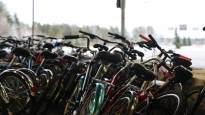According to the law, entry can be restricted if it is necessary to combat a serious security threat.
Terhi Toivonen,
Fire flower de Fresnes
The number of asylum seekers trying to reach Finland through the Russian border has increased significantly in recent weeks. According to ‘s information, the government will implement the restriction measures enabled by the Border Guard Act on the eastern border with a quick schedule.
According to ‘s information, the decision on the first steps will be taken early Wednesday evening. Minister of the Interior Mari Rantanen (ps.) will tell you more about the restrictions on Wednesday at 5:30 p.m.
We found out how many asylum seekers have entered the country through the eastern border this fall compared to the refugee crisis eight years ago, and how the matter was resolved then.
1. In 2015–2016, 1,800 asylum seekers, now around 230
Prime minister Petteri Orpo (collective) compared the asylum seekers who came through the Eastern border in recent weeks to the situation in 2015 and 2016. At that time, almost 1,800 asylum seekers came to Finland from Russia through the Raja-Joosepi and Salla border stations.
Now the asylum seekers have arrived in Nuijamaa and Vaalimaa via the border stations. A total of 233 people have come since August by Wednesday morning. Throughout the beginning of the year, 247 people have applied for asylum at the eastern border. This means that 94 percent of the applications were submitted during the fall. Within a week, the number of visitors has grown rapidly.
Eight years ago, it was about organized human smuggling, where Russia was used as a transit country. It was estimated that the Russian security service had a hand in the arrangements for entry into the country. Taking the asylum seekers to the Finnish border was seen as Russia’s gesture to Finland.
The same assessments have been presented this time as well.
Finland is now a member of the military alliance NATO, and in the process of concluding a bilateral defense cooperation agreement (DCA) with the United States.
President Sauli Niinistö estimated on Wednesday during his visit to Germany that the agreement could be behind Russia’s actions. Russia has threatened along the way with “retaliation” if Finland joins NATO or deepens military cooperation with the United States.
2. Where do the asylum seekers come from?
This time, the asylum seekers coming across the eastern border are from the Middle East and Africa, mainly from Iraq, Somalia and Yemen.
In 2015–2016, a large number of asylum seekers came from Asian countries, such as Afghanistan and Nepal, but also from the Middle East, Iraq and Syria.
3. Border crossing can be restricted if it is necessary
According to ‘s information, the government will decide on limiting border crossings in the early evening on Wednesday in an extra session of the Government Council.
The purpose is to decide on the means that will be put into use as soon as possible.
The law allows the closure of border crossing points or the restriction of border traffic if it is necessary to combat a serious threat to national security or public order.
The Chancellor of Justice, among other things, weighs the necessity and proportionality of actions.
According to section 16 of the Border Guard Act that came into effect last year, the asylum search can also be concentrated at one or more border crossing points.
The asylum search can be concentrated if there is either an exceptionally large number of immigrants in a short period of time, or on the other hand – if there is information or a well-founded suspicion that the immigration is caused by the influence of a foreign state or other actor.
The point is therefore related to combating hybrid influence.
4. Why can’t the arrival of asylum seekers be resolved like last time?
At the moment, the state leadership of Finland and Russia do not have the same discussion relationship as there was before Russia’s war of aggression in Ukraine.
Russian border authorities have previously prevented entry to the Schengen area without proper documents. The Finnish border authorities have already been in contact with the Russian border authorities about the changed practice. Russia has not changed its approach.
Petteri Orpo, who was the Minister of the Interior in 2015–2016 said that he had visited the headquarters of the Russian security service FSB negotiating how to stop the arrival of asylum seekers at the Finnish border. The phenomenon was suppressed by the fact that Finland concluded an extraordinary border agreement with Russia lasting six months.
President Niinistö’s behind-the-scenes communication with Russia also had an impact on the matter. In a recent book, Niinistö estimates that the reason for Russia’s actions would have been Russia’s response to the acceleration of Finnish and NATO training activities.
